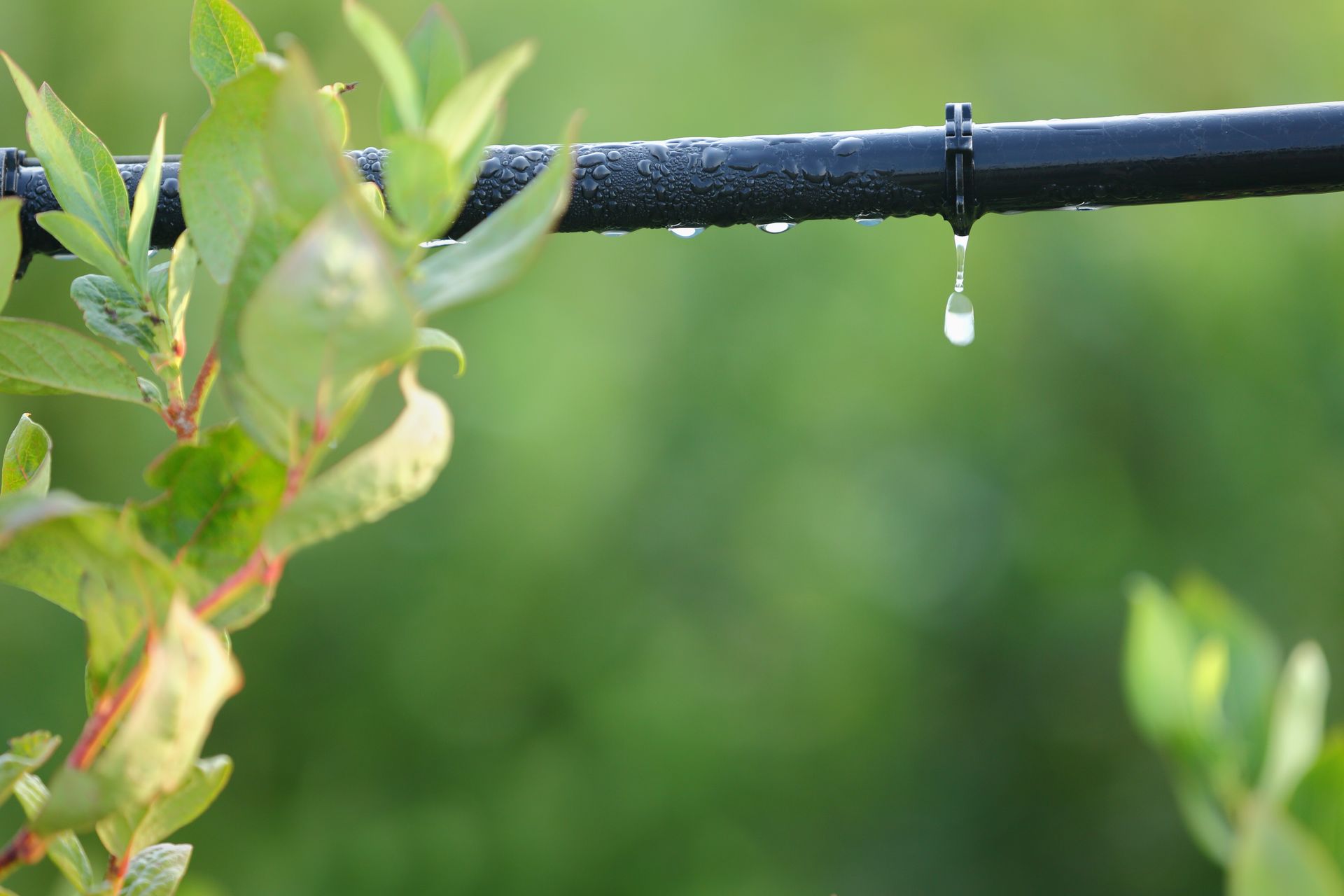Sweet New Earth is an ad free and entirely reader-supported site.
When you purchase products through links on our site, we may earn a commission which supports our reviews.
Learn more.
How Does Drip Irrigation Work?

Drip irrigation works by delivering a slow and controlled flow of water directly to a plant's root zone. It it's an extremely efficient way to water plants that maximizes plant growth while minimizing water waste.
So how does drip irrigation work? Why is it so efficient? In this guide, we explain how a drip irrigation system works by applying water to the roots of the plants.
Table of Contents
How Does A Drip Irrigation System Work?
A drip irrigation system is a type of irrigation that delivers water to the plant's roots directly. Since the water 'drips' drop by drop into the roots, the system minimizes water wastage. It also provides plants with the necessary amount of water they need for survival and growth.
A drip system usually comprises pipes and small tubes called drip emitters. These emitters, or "drippers," are installed close to the base of a plant. The emitters release water to the plant's roots in a controlled manner through a porous material or small holes.
To maximize efficiency, the best drip irrigation systems have drip irrigation controllers. This is just a small device that controls when your plants will be watered, and some of them can adjust to local weather patterns.
Why Is Drip Irrigation Work So Well?
Drip irrigation systems have become the irrigation systems of choice today due to their benefits. Here are some ways a proper drip irrigation system can be good for your plants and yard.
Drip irrigation is one of the most economical and efficient ways to water your plants. Although it's common in dry areas, it can be used anywhere. Unlike other irrigation systems, such as typical lawn sprinklers that are only 65% to 75% efficient, drip irrigation is 90% efficient[1].
Water Conservation
Being an efficient irrigation system, drip irrigation saves a lot of water. Instead of flushing plants with water, a drip system only provides small amounts of water to the plant's roots for efficient absorption.
Many farmers prefer this method over other irrigation systems since it can save up to 50% of water.
Improved Plant Health
Plants need a consistent yet controlled water supply to ensure they do not get too much or too little water. While overwatering can cause root rot and other diseases, underwatering can lead to plant stress.
The slow, steady flow of water in drip irrigation prevents these issues. Instead, it allows stable soil moisture levels, which helps promote healthy root growth and plant development.
Weed Control
When the soil surface is always flooded with water, there's a risk of weed growth. Weeds use up the plant's water supply to flourish themselves.
A surface drip irrigation system can prevent this by providing water directly to the plant. It helps discourage weed growth and reduces competition for nutrients and water between plants and weeds.
Reduced Soil Erosion
Excessive water runoff, which is common in other irrigation systems, results in soil version. But drip irrigation prevents this by maintaining a consistent soil moisture level to preserve soil structure.
Low Energy Costs
Since a drip irrigation system operates at a much lower pressure than a sprinkler system, it uses less energy. Thus, drip irrigation systems result in cost savings.
Improved Fertilizer Efficiency
Farmers can combine drip systems with fertilization methods. Farmers can ensure the direct supply of fertilizers to the plant's roots by applying fertilizers in a drip system.
The method enhances nutrient absorption for plants. It also prevents nutrient leaching, as fertilizers don't mix with the surface water and run off into nearby water bodies.
Pest Control
A drip irrigation system keeps the plant's trunk and foliage dry. It lowers the risk of fungal diseases, especially those caused by pathogens that thrive in moist conditions.
The Components That Make Drip Irrigation Work
How does drip irrigation system work? To fully understand this, you must know about the components used in drip irrigation. Here are the most integral ones.
Dripper Line
The dripper line or drip tubing is the main component in drip irrigation systems. The tubing is designed to deliver water precisely and efficiently to plant roots.
Most trip tubes are made of flexible plastic. You can find these tubes in different wall thicknesses and diameters. The smaller the diameter, the lower the water delivery rate.
The dripper line has built-in drippers or emitters evenly spaced throughout the tubing. These emitters have tiny channels or openings through which water flows.
In a drip irrigation system, water moves through the dripper line when the water source is operational. The emitter spacing in a dripper line can vary depending on the type of plant you want to water and its watering requirements.
Make sure you select the right dripper line for your plants. For example, if your plant requires more water, opt for a dripper line with a larger diameter and more emitters.
Emitters & Drippers
As mentioned, the emitter is responsible for the flow of water to the plants. The main type of emitter is a dripper, which releases water in droplets. You can insert a dripper into the main dripper line or a lateral line, depending on the plant's water requirement.
Another type of emitter is a micro-sprinkler. It's similar to a conventional sprinkler but operates at lower flow rates and water pressures. Micro-sprinklers distribute water to plants in a spray or fine mist pattern.
Two main types of emitters include:
- Online 'Point Source' Emitters: Point source emitters apply water slowly to the plant. They may be available in different styles, such as 10⁄32 threaded and self-piercing barb. Most of them are color-coded so that you can identify water flows.
- Inline Emitters: An inline emitter is built into irrigation tubing. These emitters are spaced at regular intervals throughout the dripperline's length.
Fittings
The fittings in a drip irrigation system refer to the connectors used to join tubing sections. They are designed only to allow water to flow in one direction, thus preventing any backflow.
When choosing irrigation fittings, you must check the size requirements mentioned on the tubing you've bought. For example, if you get 1/4" poly tubing, you should get 1/4" fittings.
Common types of drip tap fittings include:
- Compression Fittings: These fittings come in different 'inside diameters' and are commonly used in drip irrigation systems. The downside to these fittings is that they are not reusable. You cannot move them from one point in the dripper line to another since they lose shape when removed.
- Elbows: An elbow is a bend that allows water to change direction in the surface drip irrigation system. Elbows are available in different angle configurations, such as 45 degrees and 90 degrees. You'll find these fittings in two main configurations; threaded and barbed.
- Couplings: These connect two pieces of the irrigation tubing. They usually have barbed ends you insert into the tubing and later secure with a compression fitting or a clamp.
- End Caps: An end cap seals off the tube's end.
- Perma-Loc Fittings: These fittings are durable, reusable, and easy to use. You can buy Perma-Loc couplings and elbows for your irrigation system.
Pressure Regulators
Pressure regulators reduce water pressure to ensure a consistent water supply. Drip irrigation systems usually operate at a pressure of under 20 psi. A pressure regulator lowers the incoming water pressure to keep it below the threshold.
Filters
Besides a pressure control valve, you can install several types of filters to increase the efficiency of a drip irrigation system. Some types of filters include:
- Screen Filters: These act as mesh screens to trap dirt and debris particles.
- Disc Filters: These filters have multiple stacked discs that act as a filter to trap dirt.
- Media Filters: These filters have a gravel or sand bed that filters contaminants.
The filters you choose for your irrigation system will depend on your area's water quality. Other factors that impact filter selection include flow rate and particle size distribution.
Flush Valves
Flush valves remove sediment, contaminants, and debris from a drip irrigation system. These valves flush out any unwanted material that may render a drip system ineffective or cause blockages in the dripper line.
There are two main types of flush valves:
- Manual: A manual flush valve is operated manually. You have to open the valve manually to let water flow through the system to carry debris away. Manual valves are commonly used during drip system maintenance, shutdown, and startup.
- Automatic: These flush valves have an automatic mechanism to trigger water flushing. Many of these valves operate using a sensor, pressure differential, or timer.
End of Line
The end of line is the drip tubing's endpoint. It is the last point through which water flows to the plant.
You have to install an end cap to shut off the tubing at the endpoint. The end of line ensures that water does not leak out of the system and keeps debris away from the plant.
Backflow Preventer
When using drip irrigation, it helps to install a backflow preventer. Typically, the backflow preventer is installed at the junction of the main water line and the drip irrigation system.
Backflow can occur if the irrigation system's pressure is greater than the water supply's pressure. But the backflow preventer has check valves that prevent reverse direction movement.
Learning How Does Drip Irrigation Work Conclusion
How do drip irrigation systems work? Drip irrigation, also called trickle irrigation, provides a slow and consistent stream of water to the plants' roots.
If you plan on using drip irrigation to water plants rather than using the good old garden hose, you won't be disappointed. The glossary in our guide should help you understand which components you need to set up a drip irrigation system.
References
- Drip Irrigation, University of Rhode Island, accessed 10 November 2023, <https://web.uri.edu/safewater/protecting-water-quality-at-home/sustainable-landscaping/drip-irrigation/>.

Carl Anderson
Carl Anderson is an avid outdoorsman with a keen interest in writing about and reviewing tools. He has over 20 years of writing experience and the only time he isn't feverishly typing away at his computer is when he's outside in nature working on his projects. You can learn more about him here.
Join our community!
Join to receive guides, insights, and the latest gardening deals!
Newsletter
Thank you for subscribing!
Please try again later
Sweet New Earth is reader-supported. When you buy through links on our site, we may earn an affiliate commission.
All Rights Reserved | Sweet New Earth
